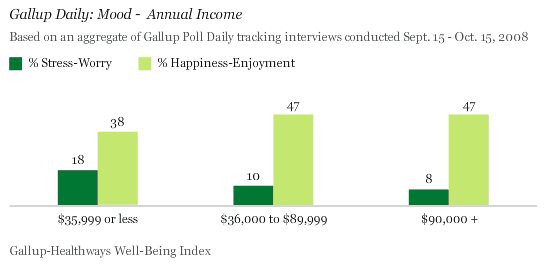WASHINGTON D.C. -- Although Americans continue to be emotionally affected by the nation's economic crisis, they seem to be slightly less affected than they were during the initial shockwaves in mid-September, when happiness and enjoyment without a lot of stress and worry consistently hit record lows for the year. During the period of Sept. 15 to Oct. 15, there were eight days on which Americans' collective level of happiness and enjoyment without a lot of stress and worry dipped below 40%. Since then, the same has only happened once, on Nov. 6.

The initial downswing in Americans' moods came as the full scope of the economic crisis began to unfold, with Americans' levels of happiness hitting lows of 37%, 38%, and 39% eight times throughout the last two weeks of September and first two weeks of October. Prior to that, happiness had been at higher levels, hitting at or above 40% every day from Sept. 1-14, with previous lows also coinciding with negative financial news.
The Gallup-Healthways mood measure, which asks Americans 18 and older to reflect on the level of happiness and stress they experienced the day before the survey, has shown consistent (and not surprising) upswings in mood on weekends and holidays for most Americans. Prior to September, Gallup found that 58% of Americans reported a lot of happiness and enjoyment without a lot of stress or worry on a typical Saturday or Sunday compared to 46% on a typical Monday. In contrast, the week that saw the collapse of Washington Mutual and intense strife on Capitol Hill over the proposed bailout plan, happiness sank to uncharacteristic weekend lows of 53% on both Saturday, Sept. 27, and Sunday, Sept. 28.

Starting the week of Oct. 13, Americans' moods began to pick back up, with happiness staying at 41% or above for six consecutive days and reaching a typical weekend level of 57% on Saturday, Oct. 18. Happiness remained above 40% during the rest of October, as enthusiasm for the election picked up toward the end of the month, turning attention away, slightly, from the fiscal crisis.
Immediate Reaction by Group
Looking more closely at the Gallup-Healthways data collected Sept. 15- Oct. 15, when happiness and enjoyment consistently hit record lows, reveals that Americans with more negative perceptions of the economy were far more likely to report lower levels of happiness and higher levels of stress, than those with a more positive economic outlook.

The Gallup-Healthways data also reveals that Americans with an annual income of $36,000 or more per year were more likely to experience happiness during this time period than those making $35,999 per year or less.

Additionally, Americans with one or more children in their household also report lower levels of happiness, and those with six children or more experienced a much higher level of stress.

Together, it is clear that the effect of the economy on daily happiness-stress is likely compounded for people with less income and more children.
Survey Methods
For the Gallup Poll Daily tracking survey, Gallup is interviewing no fewer than 1,000 U.S. adults nationwide each day during 2008.
The U.S. mood results are based on data from Sept. 15-Nov. 10, 2008, the maximum margin of sampling error is ±2 percentage points.
Interviews are conducted with respondents on landline telephones (for respondents with a landline telephone) and cellular phones (for respondents who are cell phone only).
In addition to sampling error, question wording and practical difficulties in conducting surveys can introduce error or bias into the findings of public opinion polls.
